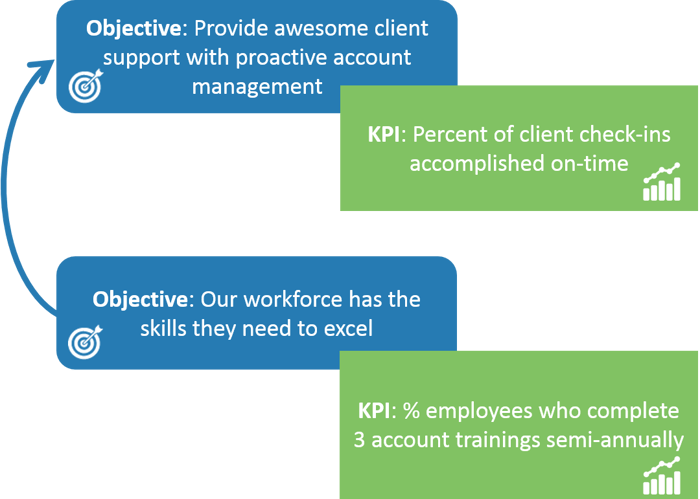Key Performance Indicators are metrics that quantitatively illustrate the performance of a strategic objective. KPIs should accomplish three primary objectives:
- Control Performance - KPIs should articulate performance standards and incentivize desired behaviors
- Monitor Health and Progress - Measurements quantify the performance of strategic objectives
- Challenge Assumptions - KPIs reveal the underlying cause/effect logic of the Balanced Scorecard and help test assumptions. If your KPI is performing poorly, do you have the right strategy to support it?
Click here for a full explanation of Balanced Scorecards
Frequently, I see organizations compose a KPI that seems quantitative in nature, but in practice is a re-wording of a strategic initiative. Let's say we have an internal process objective called "Provide awesome client support with proactive account management." I can think of several ways to measure the performance of that objective, but to start, here is an example of a bad KPI:
"New CRM system implemented by March 2017".
You could defend this and say, "Hey, a new CRM system is essential to account management and we're measuring the progress of our CRM implementation." That's cheating. If you are measuring whether or not something is done, you are tracking a project, not a KPI. A CRM system may very well be essential, yet the implementation status is not a Key Performance Indicator because it fails to monitor the health and performance of the proactive account management objective.
A better KPI might be:
"Percent of client check-ins accomplished on-time."
This new KPI clearly articulates a performance standard, and allows us to monitor our performance over a longer time horizon. While it is sometimes appropriate to timestamp a KPI with a target ("achieve 90% on-time client check-in by 2020"), be wary of confusing targets with project implementations.

Working with the same hypothetical account management objective, here is another example of a bad KPI:
"All employees complete 3 account management trainings"
By creating a very narrow picture of objective performance, this KPI suffers from many of the same problems as the previous example. It provides a poor picture of objective performance and falls dangerously close to a "complete/incomplete" status.
Another way to approach this KPI might be:
Percent of employees who complete three account management trainings semi-annually
By rewording the KPI, the organization more clearly articulates an ongoing targets and expectations. A semiannual target clarifies expectation deadlines, and using a rate instead of a raw number provides a method to track performance beyond "is it done?"
While better, this KPI still suffers from a crucial structural issue. The relationship between the KPI (% employees trained) and the strategic objective (provide awesome account management) is a bit fuzzy. Does training tell us how well we are handling praoctive account management, or is it rather the means to an end? I would argue it is the latter.
In this situation, the KPI may be better aligned to a different strategic objective. If there is a strategic objective in the Learning and Growth perspective that deals with employee skills and training, moving the KPI might be a good option.
The cool thing about the Balanced Scorecard is that the causal logic neatly snaps into place when you illustrate the relationships between objectives/perspectives.

Building on our previous example, we can see how the lower-level objectives drive the performance of higher level objectives. By appropriately aligning KPIs to the right objectives, root-causes can emerge. If client check-ins are off, then perhaps there is an underlying training issue lower down in the strategy map.
KPIs Evolve
No organization waves a wand and the right KPIs magically appear. Finding the best KPIs will take time and a willingness to experiment. Even once a solid set of metrics is in place, the strategy will inevitably change, rendering some measurements obsolete.
With so much in flux, it is especially important to have a consistent, repeatable approach to key performance indicators.








